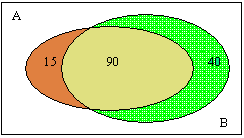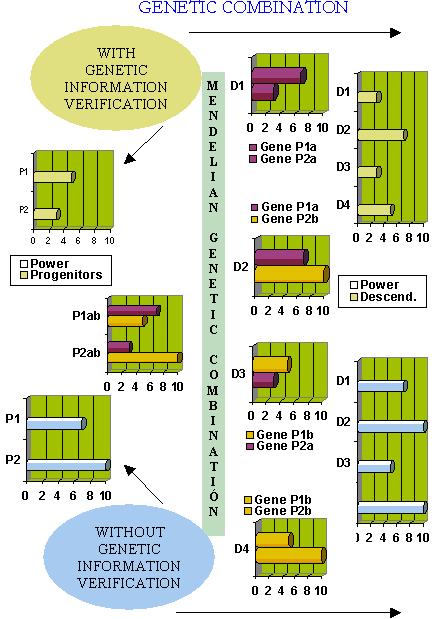...
Sexual differentiation and LoVeInf method
Another characteristic of sexual differentiation, complementary and more potent than the previous one, allows Nature to decide which of the two genetic sources use; in other words, how to take advantage of the second source of information.
The advantage is that the new method can verify the genetic information when it is essential to avoid errors by comparing or filtering the two sources.
In the theory of evolution, the central aspect is not the particular mechanism but the method; in this case, the LoVeInf method –Logical Verification of Information.
Let us see some examples to show the advantages of sexual differentiation:
Computer spaceships
Errors in spaceships can suppose a high material and personal cost; therefore, it would be nice to have high reliability that no crucial mistake will take place.
If three identical computers do complicated computer calculations, they will verify that the results are correct. In the improbable, although possible case, one of them failed. We could assume well enough the others’ output because it would be much more doubtful that two computers make an error simultaneously and with identical deviation.
The process verifies the information between three sources; nature only has two sexes, but one brain, many genomes. *
Complex calculations
An example of two sources could be asking two people the result of a relatively complicated calculation or an event's exact date. If the two people give the same answer, we could be almost sure that both have given the correct answer. Although it could be relatively easy to be mistaken in a difficult question, to commit precisely the same error is not probable. Of course, in those inconsistent cases, some alternative must be available to choose a particular answer.
-
Neural networks
If the previous example had two sources, a different case could be some Nature functions using two billion little computers or neurons, half of which from the genetic information of an ancestor and the other half with the other ancestor's genetic load.
With this configuration, it is possible to apply the method LoVeInf and to work without its application. For example, a human cognitive process could decide based on the first hundred thousand answers. It would not be impossible that a brain operation, on some occasions, responds to the design of this example.
The last example presents numerous advantages concerning the simple selection of one or another inherited genetic source. First, it allows taking advantage of the two sets of genetic information. Secondly, the same group of cells serves different cognitive functions, even cognitive tasks of diverse nature.
NEWS ABOUT THE THEORY OF EVOLUTIONThe mysterious behavior of the X chromosome
In some brains, the X chromosome predominated in the left hemisphere and the father's Y chromosome in the right one. In some mice, the father dominated one eye and the mother the other. The diversity extended to the entire mouse.
El País 06-12-2014
It is like the operability of genetic information of both ancestors could change depending on the different filters or conditions applied and, at the same time, keep the full potential.
The mechanism to carry out the method LoVeInf of sexual differentiation can be as simple as to verify if both genes produce the same protein or not. However, it will not always be possible to maintain this compatibility. If the LoVeInf method carries out a new being’s initial processes, it is possible that, once an organ develops with specific characteristics, the option of maintaining different features disappears.
Thus, sexual differentiation seems necessary when arriving at a certain degree of complexity in living beings' development.
The method LoVeInf and sexual differentiation explain the relevance of the unconscious mechanisms in sexual selection.
Insofar as possible, the LoVeInf method will keep the compatibility of different filters or conditions on cognitive processes and, consequently, the two genetic sources' maximum potential. It will be easier to preserve adequate flexibility in characteristics associated with continuous variables than discrete ones. What looks like one characteristic will often be a group of somewhat multifaceted attributes due to the different scales, macroscopic and microscopic.
In any combination, each parent passes on only half of his or her genes to their daughter. However, her olfactory preferences are defined exclusively by the combination of genes the father has passed on.
The other half that the father has, but the daughter does not, is irrelevant. Moreover, the mother’s genes also unrelated.
El País 23-01-2002. Nature Genetics
Now, let show more examples to fully understand the LoVeInf method and the advantages of sexual differentiation.

Relational intelligence
It is composed of multiple cognitive sub-functions. To avoid unnecessary controversies, we assume intelligence to respond correctly to IQ tests, resulting in a continuous variable with a normal distribution of 100 as average and standard deviation subject on the particular trial.
The diagram shows the intellectual potential associated with two genes; we use the term gene for simplicity; however, it could easily refer to several genetic code pieces situated in different places.
The genetic code of progenitor A has a potential of 105 and B of 130, having shared cognitive functions of 90.
If it is a characteristic for which nature applies the LoVeInf method, the descendant's potential would be 90, while if it were not operative, it would be 145. As one can see, these results are equivalent to those of the Set theory regarding math intersection and addition.
Automobile brakes
This example is fully explained on the Web page about dominant and recessive genes within sexual differentiation while talking about cars' evolution.
Math example with letters
If the genetic code of a progenitor had the human cognitive functions: {a, b, c, d, e}
If the method LoVeInf is applied and the other ancestor's genetic code is {a, b, c}, the descendant will have the potential corresponding to cognitive functions {a, b, c}. If the LoVeInf method were not applied would have the potential {a, b, c, d, e}
Nevertheless, if the LoVeInf method operates and the other ancestor's genetic code is {a, f, g, h}, the descendant will have the potential corresponding solely to the function {a}. On the opposite case, if the LoVeInf method were not operative, would have {a, b, c, d, e, f, g, h}
Mendelian genetics
To simplify, in the following diagram of Mendelian genetics and sexual differentiation, we will assume that the genetic code of grander potential always includes 100% of the potential associated with the other genetic code. We have also eliminated evolution that would transmit improved genes to descendants.
Method of Verification
of Genetic Information (LoVeInf)
The column to the left shows the potential of the two progenitors associated with the genetic codes represented in the next column, the upper part with the Logical Verification of Information method, and the lower without its implementation.
By our definitions, the progenitors' potential is equal to their genetic code with lesser value when using the LoVeInf method and higher value when it is not operative.
The third column graphically represents the four possible combinations of the progenitor’s genes by Gregor Mendel’s law.
Lastly, in the column to the right are the potentials associated with the descendant’s genes. The upper part is with applying the LoVeInf method, and the lower with the opposite case.
It is worth pointing out that it is a specific method of evolution within sexual differentiation. The aim is not to generalize it at any time, although it could be widespread. Likewise, whether the LoVeInf method is applied or not, genetic codes transmitted to descendants will have the same value, given that the LoVeInf refers to the worth of individuals and not of the genetic code.
The consequences of the Mendelian genetic combination and sexual differentiation from the study of the previous diagram are:
-
The inherited potential relates to the progenitors’ two genes, without either acting as dominant or recessive genes in Mendelian genetics.
The behavior will be somewhat different from the Mendelian significance and depend on the paired gene's potential; the smaller gene will be significant when the LoVeInf method is applied. This behavior will be relevant because the more significant gene includes the gene with less potential. In other words, the intersection we saw in the figure of the math’s Set theory would be a genuinely useful part.
See these roles when applying the LoVeInf method for gene B of progenitor one, given that it is not the significant gene of descendant three, but descendant 4.
In some instances, the genetic potential fully maintains, depending on the operability of the specific functions carried out.
-
When the LoVeInf method applies:
There is a 50% probability that the descendants’ potential will be the same as the lesser of the progenitor’s capabilities.
The maximum potential will be that of the second most potent gene whenever it is not from the same progenitor with the most robust gene; in this case, the maximum potential referred to will be equal to the second less potent gene.
- When the LoVeInf method does not apply:
Descendants’ potential has a 50% probability of being equal to that of the progenitor with the higher potential.
The minimum potential will be of the second less potent gene whenever it is not from the same progenitor with the least forceful gene; in this case, the minimum potential will be equal to the second most potent gene.
These consequences of the Mendelian genetic combination and sexual differentiation may verify this evolutionary method's real existence and the supporting theory through the corresponding statistical analysis of specific cases of sexual differentiation.
In particular, the CEL postulates the LoVeInf method is operative for the characteristics measured by an IQ test and for math memory, a memory with almost absolute reliability.
Keeping in mind that for intelligence, nature constructs organs according to both genetic sources. The case of not requiring certainty of responses –the opposite of intelligence in the strict sense of the word– would be intuition. As we know, the hunch is more potent than cleverness and less reliable. It will be contingent on the quantitative difference between the two genetic codes; more precisely, of the difference between the intersection and the addition of the potential of both genetic sources.
For semantic memory and musical abilities, the CEL vindicates the LoVeInf method is not applied; these could, however, be used for empirical verification if there were appropriate indicators.
Finally, it is imperative to mention The EDI Study, with sexual differentiation, empirically confirms the LoVeInf method's existence and an additional hypothesis relating to sexual selection.
